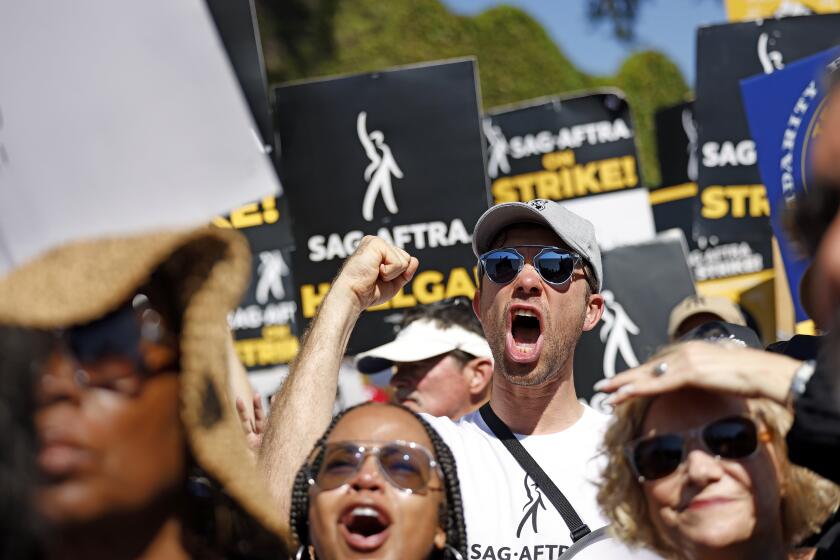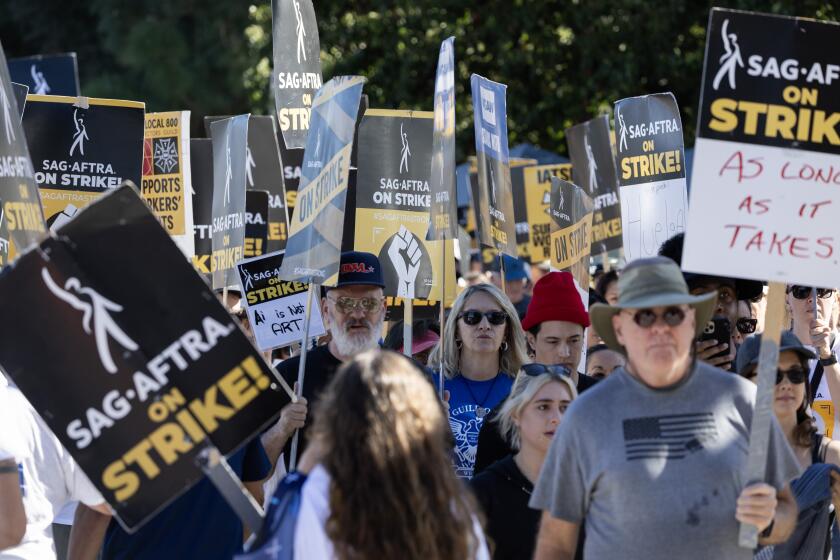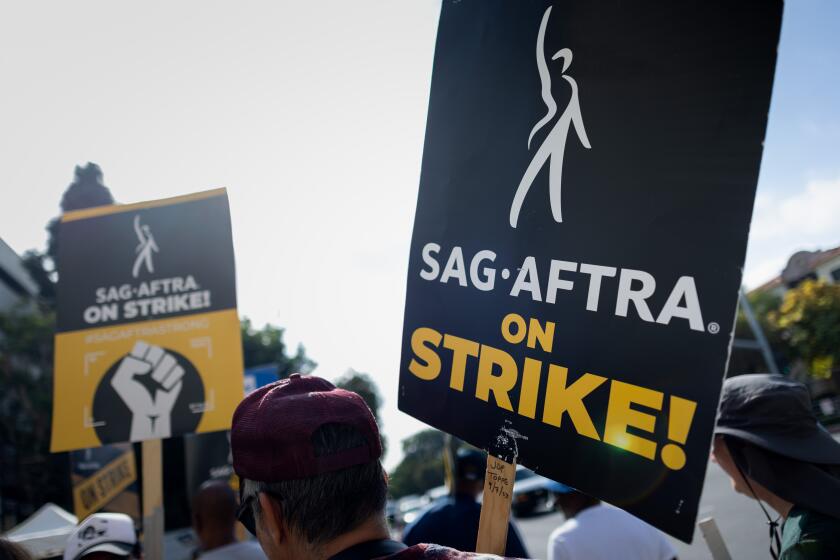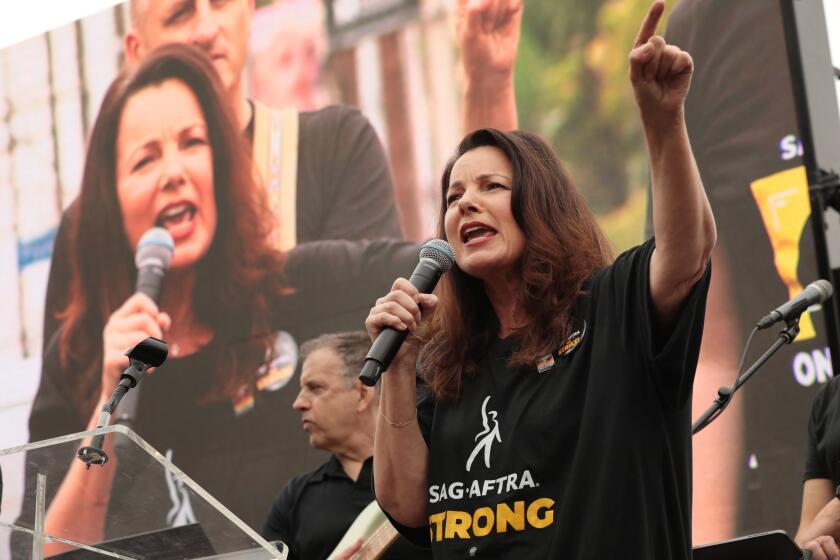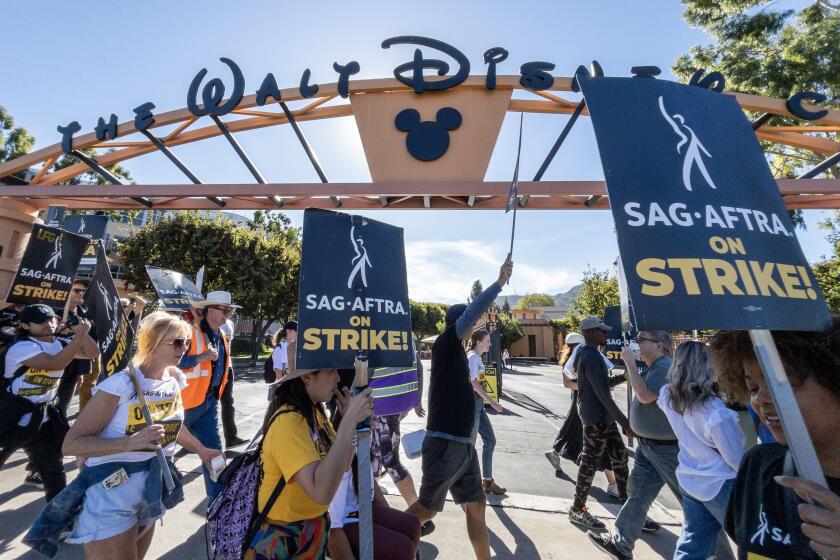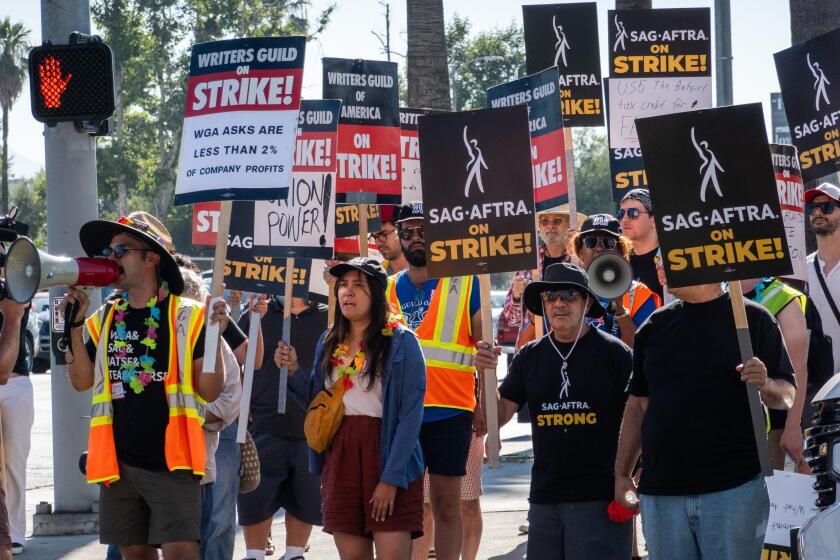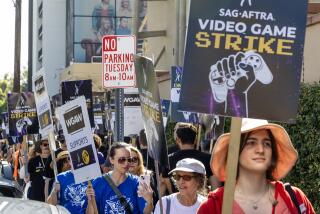The end of the actors’ strike seemed within reach. Why is a SAG-AFTRA deal taking so long?

- Share via
About this time last week, the major Hollywood studios were hopeful and the performers union SAG-AFTRA was cautiously optimistic that a tentative deal to end the actors’ strike was within reach.
One hundred and seventeen days into the walkout that has ground the entertainment industry to a near-halt, such a settlement remains to be seen. On Monday afternoon, the Screen Actors Guild-American Federation of Television and Radio Artists said in a statement that there still were “several essential items” the sides had yet to agree on.
If approved by union members, the tentative contract would end a strike that lasted nearly four months and shut down Hollywood film and TV productions.
Late Tuesday night, the guild posted another update, informing members that the negotiating committee met with the Alliance of Motion Picture and Television Producers on Monday night and “spent 10 hours deliberating” the following day.
“We will continue on Wednesday,” the union said in a statement. “We appreciate your patience and support while we finish our work.”
This came after the union formally responded to what the Alliance of Motion Picture and Television Producers described as its “last, best and final offer,” the contents of which are starting to emerge through anonymous sources. The parties have been going back and forth for about two weeks of frequent meetings in an effort to resolve their labor dispute.
SAG-AFTRA has approved a deal from the studios to end its historic strike. The actors were on strike for more than 100 days.
Despite signs of progress, a deal between the entertainment companies and SAG-AFTRA has proved elusive. So what exactly are the outstanding “essential items” preventing the parties from reaching a settlement?
It’s no secret that the use of artificial intelligence in filmmaking remains a major sticking point. The labor agreement being negotiated is lengthy and complex and covers dozens of issues, including the use of AI and other technologies, where there is little precedent for a solution.
Both sides are fearful that giving away too much on AI will come back to haunt them as these technologies rapidly develop. Actors and studios hope to establish a blueprint that protects their rights well in the future.
SAG-AFTRA said it responded Monday to what the AMPTP described as its ‘last, best and final offer’ to end the actors’ strike
As of Tuesday morning, AMPTP President Carol Lombardini and SAG-AFTRA chief negotiator Duncan Crabtree-Ireland were still trading language on AI, according to multiple industry sources who were not authorized to comment.
“That’s clearly an area where we have some differences that are pretty significant,” Crabtree-Ireland told The Times last week. “There are a number of open issues, so I hesitate to focus in on any one specific one ... But AI is definitely an area of major concern.”
Fueling worries about the entertainment companies’ AI ambitions was a report published Monday evening by the Hollywood Reporter, which stated that the AMPTP’s latest proposal would allow studios and streamers to use AI scans of dead performers without obtaining permission from the guild or the deceased’s estates.
Performers’ union SAG-AFTRA is reviewing what the studios say is their ‘last, best and final offer’ to end the nearly 4-month-old actors’ strike.
Studio sources dispute claims that they are seeking the use of likenesses without their consent or compensation. Instead, “anytime a producer wants to re-use AI scans for future content, the producer will need to secure consent from the performer and bargain for compensation,” according to a studio source with access to the language of the AMPTP’s latest proposal.
If a performer has died, “producers must first obtain the consent of the performer’s authorized representative who represents the performer’s exclusive rights,” the source added.
David Smith, professor of economics at the Pepperdine Graziadio Business School, said he suspects that issues related to AI are likely “the primary hangup at this point.”
“The evolving nature of AI and how fast it’s developing is creating a situation where it’s hard for the sides to come to an agreement,” Smith added.
“I will not cave,” “The Nanny” star and SAG-AFTRA President Fran Drescher says in an interview, as the actors’ strike reaches 100 days. Talks with the major studios were suspended earlier this month.
There are a number of other issues on the table, such as how performers will be compensated in the streaming era.
The studios have been adamant that they will not agree to any streaming revenue sharing arrangement with SAG-AFTRA.
However, the two sides have been working on the contours of a success-based model that some sources describe as being more generous than the one that the Writers Guild of America agreed to in its recent contract. The WGA and the AMPTP agreed to a payment system in which scribes would receive bonuses for shows watched by 20% of a streamer’s domestic subscribers in the first 90 days of release.
Crabtree-Ireland told The Times last week that the guild and the studios were having productive discussions about streaming residuals but hadn’t been able to come to an agreement thus far.
“We don’t have a deal on AI yet. We don’t have an agreement about residuals, and residuals are how most actors pay their bills,” strike captain Kate Bond told The Times on the picket lines last Wednesday. “Those two things are really important. ... Until we get those two things, we’re just still out here, I guess.”
SAG-AFTRA held a massive “Unity Picket” at the Disney lot in Burbank as the union prepared for another round of talks with the studios.
Companies have made movement on issues of compensation, including basic minimum pay. SAG-AFTRA entered negotiations asking for an 11% general wage increase in the first year of the contract to offset inflation, while the studios offered a 5% hike in Year 1. The studios have moved to 7%, according to sources.
In order for an overall deal to get approved by SAG-AFTRA’s board, first the negotiations committee would need to recommend a tentative agreement. But it can be challenging to get a majority of the committee to agree to the terms.
SAG-AFTRA’s TV-theatrical negotiating committee is made up of more than 40 members that include TV and film actors, as well as people who work in stunts and voice-over. The diversity of the members can make it harder to come to a consensus on a deal that addresses the needs of the various groups, industry sources said.
“It’s well known that the larger the teams and the more diverse their perspectives, then the harder it can be to really reach a consensus,” Smith said.
“We know that negotiations are more effective when there’s just more people at the table. Of course, the other side of that is they’ve got to take this back to diverse membership and there’s multiple studios involved.”
SAG-AFTRA and AMPTP said they will resume talks Tuesday, as the actors’ strike reaches a milestone.
In addition, guild members have flooded the picket lines with deep skepticism of the studio chiefs. Social media has amplified a lack of trust between the two sides. Guild members have been openly resentful about the lack of early involvement of the entertainment company chief executives in the talks.
Top CEOs didn’t come to the bargaining table with the WGA until after writers had been on strike for more than three months. And the chiefs didn’t meet face to face with SAG-AFTRA leaders until Oct. 2 — 2½ months after guild leaders called the strike.
On Friday, studio chiefs presented SAG-AFTRA with what they called their “last, best and final offer,” signaling frustration by the AMPTP that the two sides have been unable to clinch a deal. That move was widely ridiculed on social media. Vocal WGA members and performers urged SAG-AFTRA leaders to hold out for more.
“Lol, or WHAT?” wrote “She Hulk: Attorney at Law” actor Ginger Gonzaga on X (formerly known as Twitter). “You just don’t make TV shows and movies again?”
Hollywood’s striking actors put on their best Halloween costumes as they picket outside of Netflix and other locations.
Last month, more than 5,500 members of SAG-AFTRA — including Daniel Dae Kim, Daveed Diggs, Sarah Paulson, LeVar Burton, Gina Rodriguez and Pedro Pascal — signed an open letter declaring that they would “rather stay on strike than take a bad deal.”
During a massive rally outside Walt Disney Studios in Burbank last Wednesday, Crabtree-Ireland mused that the work stoppage could easily be resolved “in a matter of days” if the studios came to the table with the guild’s desired “mind-set.”
“Whether that will happen is hard to say,” he said.
Warner Bros. Discovery Chief Executive David Zaslav addressed the strike during the company’s quarterly earnings call with analysts Wednesday morning, saying the most recent offer “met virtually all of the union’s goals” and would represent “a positive outcome for all involved.”
“We are hopeful we will reach a resolution to the SAG-AFTRA strike soon,” Zaslav said. “We recognize that we need our creative partners to feel valued and rewarded and look forward to both sides getting back to the business of telling great stories.”
More to Read
Inside the business of entertainment
The Wide Shot brings you news, analysis and insights on everything from streaming wars to production — and what it all means for the future.
You may occasionally receive promotional content from the Los Angeles Times.
